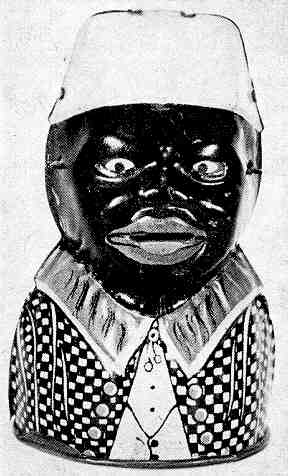"Darky Bust"
by F.H. Griffith - HOBBIES Magazine - June, 1968
 Mechanical banks made of tin are of considerable interest and
among the tin mechanicals are some real "toughies" — very difficult to add
to a collection. Take the Royal Trick Elephant, for example. After all the years since one
turned up in the 1930’s, this one is still the only known specimen. Then there’s
the Snake And Frog In Pond. Only two examples of this fine action bank are known to exist,
and these were found years ago. Also very limited are the Calumet, Magie, Little Jocko
and, of course, the greatest of all tin mechanicals, Ding Dong Bell. To the best of the
writer’s knowledge, the last Ding Dong Bell to appear on the market was in 1955 and
this had remained dormant in the Chrysler collection which was in storage for some years.
So this wasn’t the case of another specimen turning up, but rather going from one
collection to another.
Mechanical banks made of tin are of considerable interest and
among the tin mechanicals are some real "toughies" — very difficult to add
to a collection. Take the Royal Trick Elephant, for example. After all the years since one
turned up in the 1930’s, this one is still the only known specimen. Then there’s
the Snake And Frog In Pond. Only two examples of this fine action bank are known to exist,
and these were found years ago. Also very limited are the Calumet, Magie, Little Jocko
and, of course, the greatest of all tin mechanicals, Ding Dong Bell. To the best of the
writer’s knowledge, the last Ding Dong Bell to appear on the market was in 1955 and
this had remained dormant in the Chrysler collection which was in storage for some years.
So this wasn’t the case of another specimen turning up, but rather going from one
collection to another.
Another point in favor of tin mechanicals (this has been mentioned before and bears repeating) is that there is no need for concern with regard to recasts. In other words, the inexperienced collector need not seek professional advice with regard to the known mechanical banks made in tin. It isn’t likely that those individuals involved in recasting cast iron mechanical banks will attempt to reproduce any of those made of tin. Various factors, including high costs, preclude this happening and tin mechanical banks simply don’t lend themselves to being reproduced.
The foregoing brings us to another "toughie" tin mechanical, the "Darky Bust," our choice as No. 163 in the numerical classification. It is a very attractive little bank, only 3-5/8" high.
The small size of the bank is very definitely a contributing factor to its scarcity. It is not a rugged item and could not stand much abuse. The bank has excellent action but the mechanism as compared to other mechanicals is quite fragile and easily put out of order. Its chance of survival in the hands of a child wasn’t very great.
There are no markings of any kind on the bank and we don’t know what concern manufactured it. However, it is foreign made and most certainly German. Fortunately, we are able to date the bank since it is advertised for sale in the 1907 Butler Bros. Catalog. A picture of the bank is shown in this old catalog. The action is described and it sold at the fantastic price of 33c per dozen! As an original selling price, this is the least expensive of all the mechanical banks known to the writer.
The bank pictured was found in the Lebanon Springs area of New York State and is in unusually fine original condition. It is lithographed in bright colors as follows: The turban is yellow with a red tassel down the back, the face is brown with red lips and tongue and white eyes with black pupils. What appears to be a loop type earring in yellow with dash of red is in each ear. The large collar of the jacket is red with white edging. The jacket is a loud checkered yellow and black with red buttons. A white shirt and yellow string tie and vest complete the coloring of this most attractive mechanical.
To operate the bank there is a coin slot in the top of the turban. A coin dropped into this slot causes the eyes to flicker and the tongue protrudes and recedes. This action, caused by the weight of the coin, is fast and the moving parts return automatically to their respective positions. As shown in the picture, the tip end of the tongue is bent down. It was manufactured in this fashion and is of necessity so that the tongue does not recede entirely into the mouth. In the base of the bank there is a key locking coin trap for removal of coins.
To date only three specimens of this bank are known to exist. The other two have no coin trap in the base and it must follow that during some period of the manufacture of the bank the error of the omission of a coin trap was discovered and corrected. It also follows that those without traps simply had to be broken or destroyed in order to remove coins. This undoubtedly is a contributing factor to its scarcity, as is the case with the Calumet Bank where no provision was made for removal of coins.
